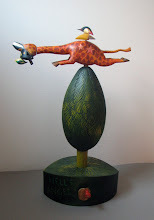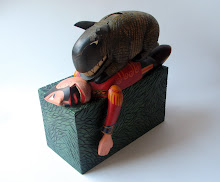Man Eater, 1992, 25 h x 20.5 w x 13.5 d cms
This blog site was set up by The Scottish Gallery to honour the work of Automatist Frank Egerton. If you have any information or own a piece of his work then please contact us.
http://www.scottish-gallery.co.uk/
Frank Egerton trained as a jeweller and silversmith but became attracted to wood by its versatility and the possibilities of scale. His Cheshire Cats and Subversive Sheep are well known to lovers of automata and toys. Beautifully carved and detailed his work delights and slyly engages our attention by surreal detail. Sheep bare their teeth sitting cross legged an armchairs; cats get to grips with bunches of roses; circus animals go through their tricks, including devouring their trainers! There are echoes of Calder's magic Circus, Sam Smith's wonderful automata, illustrations to story books such as Alice in Wonderland. There is none of the cuteness or sentimentality of so much animal-inspired art. Though the viewer is engaged and entertained he is also unsettled, mocked a little. Nothing is what it seems. The moving parts surprise and delight with their unexpectedness.
Amanda Game
The inspiration for Tipu's Sheep came from the extraordinary model of a tiger devouring a European that belonged to the Indian ruler Tipu Sultan. The piece is now housed in the Victoria and Albert Musuem, London.
http://www.scottish-gallery.co.uk/
Frank Egerton trained as a jeweller and silversmith but became attracted to wood by its versatility and the possibilities of scale. His Cheshire Cats and Subversive Sheep are well known to lovers of automata and toys. Beautifully carved and detailed his work delights and slyly engages our attention by surreal detail. Sheep bare their teeth sitting cross legged an armchairs; cats get to grips with bunches of roses; circus animals go through their tricks, including devouring their trainers! There are echoes of Calder's magic Circus, Sam Smith's wonderful automata, illustrations to story books such as Alice in Wonderland. There is none of the cuteness or sentimentality of so much animal-inspired art. Though the viewer is engaged and entertained he is also unsettled, mocked a little. Nothing is what it seems. The moving parts surprise and delight with their unexpectedness.
Amanda Game
The inspiration for Tipu's Sheep came from the extraordinary model of a tiger devouring a European that belonged to the Indian ruler Tipu Sultan. The piece is now housed in the Victoria and Albert Musuem, London.
Visit the V&A website to view the piece
Giraffe

Pig

Wednesday 29 January 2014
Friday 6 February 2009
Crafts Magazine July-Aug 1992
...in Frank Egerton's mirrors, boxes and automata there is always the echo of the fairground. In Topiary Mirror he has used particular incision to create the effect of a hedge surface, over which orange cats scamper with flowers held tight in their jaws. The pleasure one gets from experiencing his mythological world is always tempered by a slight unease at the presence of the unexpected.
Jeremy Theophilus
Jeremy Theophilus
Thursday 29 January 2009
Frank Egerton Obituary
Frank Egerton, maker and teacher, born 19 December 1942, Hyde, Cheshire, died, 19 September 2003, Liverpool, Merseyside.
Frank Egerton was an automatist with quite exceptional making skills. He worked with wood and metal in the area of figurative narrative - not an easy option, but one in which, with typical ironic humour, he revelled.
His early childhood was spent in what was formerly Rhodesia, and this was clearly an abiding influence, as lions, zebras and crocodiles all feature strongly in his work. He returned to England in 1957 and went to Audenshaw Grammer School in Manchester. During this time his father had a butcher's shop and his mother worked as a textile designer and painter. They holidayed in Blackpool,visiting the fairs, circus and infamous sideshows, a visual experience which would feed the imagery of his future work.
Egerton studied at Manchester College of Art in the 1960's and was Head of Foundation Studies at St Helens College of Art before setting up his first studio in 1975 at Appley Bridge, Wigan, Lanashire. He was appointed Artist in Residence at Drumcroon Arts Centre, Wigan in 1983 and spent seven years there prior to being appointed Course Leader in 3-Dimensional Design at Liverpool Hope University College, a position he held until early retirement through ill health in 2002. He was a true educator who always sought to bring out the best in every student, irrespective of their abilities. He was popular and highly respected by all who were fortunate to work with him or study under him.
As well as his African childhood, Egerton took his imagery from Tin Toys, the word of Lewis Carroll and his observations of everyday life. This love of rich imagery, combined with his sense of humour, emanates from his automata, which are also full of visual curiosity. His artist's statement on the Crafts Council Photostore website reads: 'To engender enjoyment and to make people smile,' which sums up his philosophy.
Egerton was never one accept what he could do comfortably, but strove constantly to break new personal barriers and set himself new challenges. In his later years he developed a real love of computer generated imagery, producing vibrant illustrations and a range of self-assembled card constructions entitled Cat Fairies and Dog Fairies. A Sense of Our Place,his final automaton and his largest (10 x 4m),was commissioned by the Bristol Health Care Trust and completed in 2001.
Egerton's life was cut short following a long illness and the world is a poorer place; it has lost an outstanding craftsman with exceptional talent who will be sadly missed. He made a lasting contribution to the lives of his family, friends, collectors and students. We were all enriched by his wit, satirical mind, observations of everyday life, but most importantly by his wicked sense of humour. He is survived by his wife Jan, and daughters, Ingrid, Rachel, Kate and Alice.
Alan Whitaker
Frank Egerton was an automatist with quite exceptional making skills. He worked with wood and metal in the area of figurative narrative - not an easy option, but one in which, with typical ironic humour, he revelled.
His early childhood was spent in what was formerly Rhodesia, and this was clearly an abiding influence, as lions, zebras and crocodiles all feature strongly in his work. He returned to England in 1957 and went to Audenshaw Grammer School in Manchester. During this time his father had a butcher's shop and his mother worked as a textile designer and painter. They holidayed in Blackpool,visiting the fairs, circus and infamous sideshows, a visual experience which would feed the imagery of his future work.
Egerton studied at Manchester College of Art in the 1960's and was Head of Foundation Studies at St Helens College of Art before setting up his first studio in 1975 at Appley Bridge, Wigan, Lanashire. He was appointed Artist in Residence at Drumcroon Arts Centre, Wigan in 1983 and spent seven years there prior to being appointed Course Leader in 3-Dimensional Design at Liverpool Hope University College, a position he held until early retirement through ill health in 2002. He was a true educator who always sought to bring out the best in every student, irrespective of their abilities. He was popular and highly respected by all who were fortunate to work with him or study under him.
As well as his African childhood, Egerton took his imagery from Tin Toys, the word of Lewis Carroll and his observations of everyday life. This love of rich imagery, combined with his sense of humour, emanates from his automata, which are also full of visual curiosity. His artist's statement on the Crafts Council Photostore website reads: 'To engender enjoyment and to make people smile,' which sums up his philosophy.
Egerton was never one accept what he could do comfortably, but strove constantly to break new personal barriers and set himself new challenges. In his later years he developed a real love of computer generated imagery, producing vibrant illustrations and a range of self-assembled card constructions entitled Cat Fairies and Dog Fairies. A Sense of Our Place,his final automaton and his largest (10 x 4m),was commissioned by the Bristol Health Care Trust and completed in 2001.
Egerton's life was cut short following a long illness and the world is a poorer place; it has lost an outstanding craftsman with exceptional talent who will be sadly missed. He made a lasting contribution to the lives of his family, friends, collectors and students. We were all enriched by his wit, satirical mind, observations of everyday life, but most importantly by his wicked sense of humour. He is survived by his wife Jan, and daughters, Ingrid, Rachel, Kate and Alice.
Alan Whitaker
Subscribe to:
Posts (Atom)



